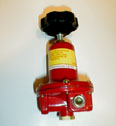- Joined
- Jan 23, 2008
- Messages
- 65,431
- Reaction score
- 10,793
In going all grain a few years ago, I bought the least expensive yet functional propane system I could find. What I found was an Outdoor Gourmet (available through Academy Sports) Hurricane type burner casting fitted with a typical 10psi adjustable regulator. This was a stand alone burner kit, basic flat iron stand included with breeze baffle, for $19.99 at the time and has served me very well over the years.
However, I have always suspected that what the kit advertised for heat tranfer was not in fact what it was providing. The kit claimed up to 160kbtu/hr which should have been able to heat my typical 12-13 Gallon wortl volume to a boil in record time. Well, in reality I can listen to a record before I get to a boil. Average times range from 30 minutes to 80 minutes dependent on volume, liquid temp, and ambient air. My HLT can take much longer. So, I have been trying to get as much info as I can to step up my game and upgrade my system. Here is what I have;

For those not familiar, this system consists of 3 kegs coverted to use specific tuns. Each is fitted with it's own burner (all 3 identical). The first (and highest) is the liquor tank which gravity feeds to the Mash tun (Middle) which is recirculated and currently fit with a Sabco false bottom. The boil kettle (closest to garage door) is pump fed from the MLT. Each vessle is free standing and is supported with unistrut bolted directly to the vessle. I used the blue, high temp Locktite to ensure that everything stays toghether ovber time. The cross braces at bottom serve to keep the legs spaced evenly and also allow for leveling bolts.
At cooling, I recirculate the hot wort to below 140*F through a Shirron plate chiller and from there allow a single pass through the chiller to te fermenter. By that time, the wort is equal in temp to the available water temp and is usually in the fermenter within 10 to 15 minutes max.
However, I have always suspected that what the kit advertised for heat tranfer was not in fact what it was providing. The kit claimed up to 160kbtu/hr which should have been able to heat my typical 12-13 Gallon wortl volume to a boil in record time. Well, in reality I can listen to a record before I get to a boil. Average times range from 30 minutes to 80 minutes dependent on volume, liquid temp, and ambient air. My HLT can take much longer. So, I have been trying to get as much info as I can to step up my game and upgrade my system. Here is what I have;

For those not familiar, this system consists of 3 kegs coverted to use specific tuns. Each is fitted with it's own burner (all 3 identical). The first (and highest) is the liquor tank which gravity feeds to the Mash tun (Middle) which is recirculated and currently fit with a Sabco false bottom. The boil kettle (closest to garage door) is pump fed from the MLT. Each vessle is free standing and is supported with unistrut bolted directly to the vessle. I used the blue, high temp Locktite to ensure that everything stays toghether ovber time. The cross braces at bottom serve to keep the legs spaced evenly and also allow for leveling bolts.
At cooling, I recirculate the hot wort to below 140*F through a Shirron plate chiller and from there allow a single pass through the chiller to te fermenter. By that time, the wort is equal in temp to the available water temp and is usually in the fermenter within 10 to 15 minutes max.







